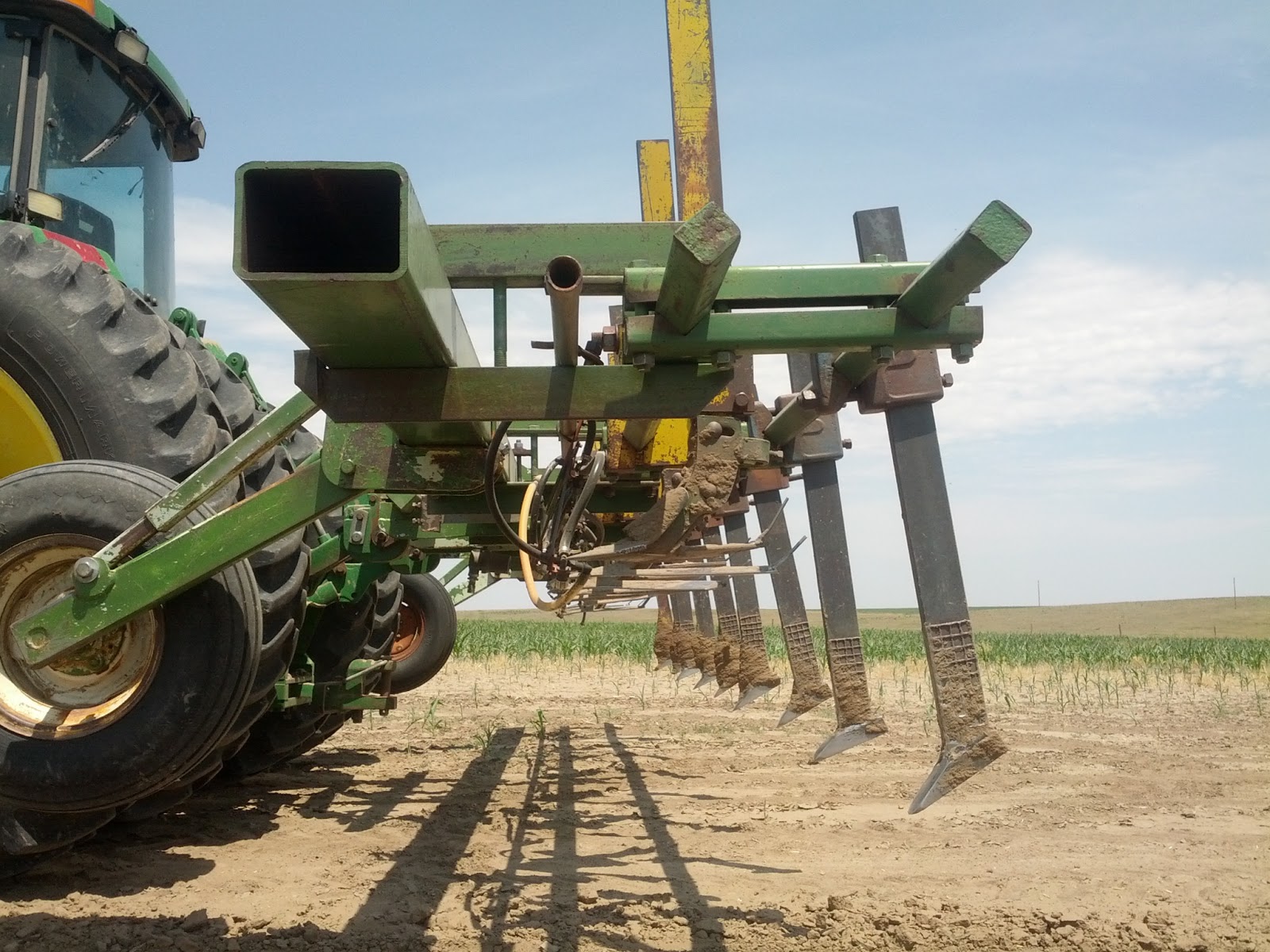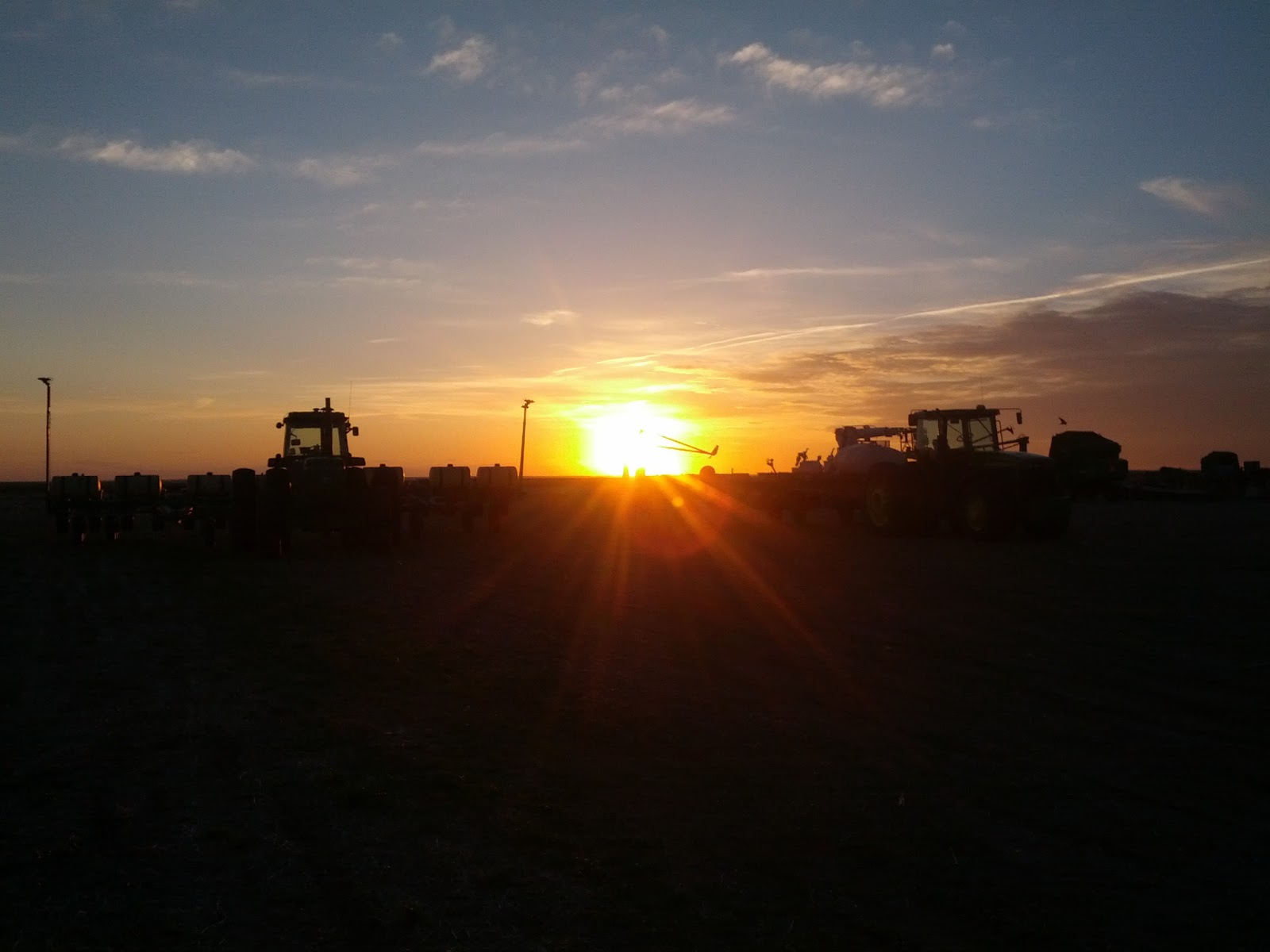After we plant our corn there is another step we like to complete on our irrigated fields before turning the sprinklers and making it rain the rest of the season. After the corn has grown to about the v4 stage (four leaves on the plant) of corn growth we like to rip the soil. We use the below implement called a "ripper" for this operation. His name is Jack.
There are actually two things that can be done with this ripper: it can cultivate, and it can rip. Cultivating is when you use the arrowhead shaped blades, called sweeps, to cut the roots of any weeds that are growing between the rows of corn.
This is very useful for volunteer corn which doesn't get killed when we spray for weeds in the fields. This is because the corn that we grow is roundup ready, so the next year's volunteer corn is also roundup ready and resistant to the chemicals we spray. Below is a bunch of volunteer corn that is a good example of why we have to cultivate some of our irrigated fields. Corn requires a lot of care in order to produce the amount of grain it does. If we were to have let this volunteer corn grow it would have not produced hardly any corn and it would have sapped the water nutrients and light from the corn that we planted this May.
When we rip we just use the bars with barbs on them, called ripper shanks, to fracture the subsoil and allow water to more easily flow into the soil. This allows our corn to get more of the moisture it needs to produce the maximum amount of corn.
Once again I got to use my Russian Satellite corrected guidance system. We were able to use the guidance lines that we created when we
planted our corn and modified them to work with our ripper. This
allowed me to rip and cultivate at much faster speed and have much more
accuracy. Not to harp on a subject, but why don't we have better satellites than the Russians. I mean, what happened to us winning the space race?
-Ryan and Jack the Rippers
Saturday, July 27, 2013
Tuesday, July 9, 2013
Corn Cam Season 2 Episode1: Planting
For most of May we were planting corn like crazy. We had a lot of acres to plant in a short amount of time, mostly because of weather delays (including snow in May... bleh).
We have a 16 row corn planter that we use for all of our irrigated fields, but it wouldn't have been enough to get all of our of our dry land corn planted in time so we decided to get two tractors rolling. We didn't have a second 16 row planter, but we did have 2, 8 row planters. So my father-in-law and I did some "farm engineering" and now we have a second 16 row planter. Having two different planters pulled by one tractor can have its difficulties, but we were able to plant a lot of acres with that setup and our fields are looking great.
We bought a tractor last December and set it up with a new guidance system. We hadn't really had a chance to try it out until we started to plant corn, and it was a lot of fun to finally get to use it. Something that I thought was interesting about this system is that it uses Russian positioning satellites to improve the accuracy of the system.
Can you imagine the response I would get if I traveled back in time to the cold war era and told a farmer that I had a tractor that drove itself and that it used Russian satellites to help steer... ?
-Planter Man Ryan
We have a 16 row corn planter that we use for all of our irrigated fields, but it wouldn't have been enough to get all of our of our dry land corn planted in time so we decided to get two tractors rolling. We didn't have a second 16 row planter, but we did have 2, 8 row planters. So my father-in-law and I did some "farm engineering" and now we have a second 16 row planter. Having two different planters pulled by one tractor can have its difficulties, but we were able to plant a lot of acres with that setup and our fields are looking great.
We bought a tractor last December and set it up with a new guidance system. We hadn't really had a chance to try it out until we started to plant corn, and it was a lot of fun to finally get to use it. Something that I thought was interesting about this system is that it uses Russian positioning satellites to improve the accuracy of the system.
Can you imagine the response I would get if I traveled back in time to the cold war era and told a farmer that I had a tractor that drove itself and that it used Russian satellites to help steer... ?
-Planter Man Ryan
Subscribe to:
Comments (Atom)







